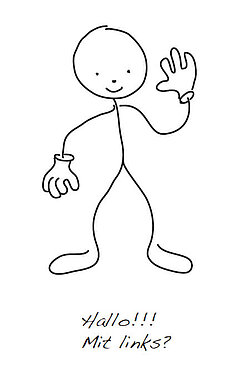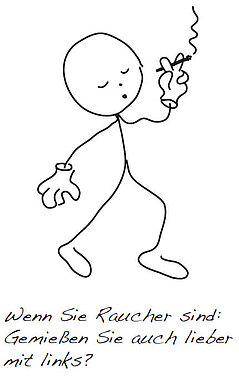The book for and about left-handers


Left-handedness – how much do you know?
Activate the English subtitle in the settings.
Left-handedness is a remarkable topic!
Why? Because it affects every second person on the planet! This book dispels popular myths about left-handers, and provides targeted advice on how to nurture left-handedness.
Left-hander or right-hander?
It is always possible to find out!
Tried-and-trusted indicators will enable you to determine whether or not you, your child or someone else you know is left-handed. Help is also at hand in the form of a new quick test for left-handedness in children and adults. Everyone benefits if left-handers are empowered to use their stronger side. This book is an indispensable guide on how to do just that.
What other readers say
“A book for the brave! And the best I’ve found on this topic!”
Sabine B., ergotherapist, customer review on amazon.de
“The best non-fiction book I’ve read in a long time. Fascinating, inspiring, well written and illustrated. A real boon for both left-handers and the uninitiated.”
Dr. Dagmar Wohlgemuth, dentist
“I recommend this book to any parent worried about their child’s handedness. I now have a much better grasp of my left-handers’ strengths and weaknesses. The guide is easy to understand and a pleasure to read.”
Tanja Schley, mother of three left-handed children
“A must for expectant parents, grandparents and teachers alike.”
Thomas Wolfram, grammar school teacher
“As a left-hander myself, I found the translation of the book to be a fascinating and informative task that gave me the chance to take a fresh look at my own left-handedness.”
The translator
There are three particularly important reasons why you should invest time in this book and the topic of left-handedness:
- Tried-and-trusted indicators will help you establish whether you, your child or someone else you know is left-handed.
- Left-handers learn differently! The tips and tricks in this book will enable you and the left-handers around you to enhance your learning outcomes – often by as much as 100 to 200 percent.
- Conversion continues to occur to this day. The knowledge contained in this book will empower you to break the vicious circle of conversion.
Here are 16 other important reasons to read this book:
- There are definitely some left-handers in your family – now you will be able to spot them all!
- Your new insights will enable you to recognise left-handers by their characteristic traits.
- You will become aware of the hidden mechanisms by which left-handed children are converted to right-handedness.
- You will gain a much better understanding of what it is like to be left-handed.
- You will learn to assess whether or not teachers at pre-schools and primary schools possess sound knowledge of left-handedness.
- Do some of your children’s most important role models exhibit a total lack of awareness when it comes to handedness? This book will put you in a position to support and guide them.
- Your new knowledge of the most definitive indicators will enable you to identify left-handers easily and reliably.
- You will learn why many highly gifted children are unable to fulfil their potential.
- Left-handers must play instruments left-handed – and you will be able to explain the reasons why.
- Struggling to decide whether or not handedness retraining is an option? Frank Steinkopf’s 20 years of experience will help you make the right choice.
- Unsure whether or not your child should receive handedness retraining during the switch from primary to secondary school? This book will enable you to make the right decision for your child.
- You will learn why left-handers are often confided in and asked for advice.
- The insights you gain will empower you to prevent your children from developing dyslexia – not least because the book reveals the main cause of dyslexia and dyscalculia.
- The book’s author, Frank Steinkopf, makes a number of surprising recommendations in connection with dyscalculia. You will soon feel the benefit of the insights and expertise he has gained during 20 years as a dyscalculia therapist.
- You will be amazed to learn that most polymaths are left-handed. They use the characteristic strengths of left-handers to extraordinary effect.
- Looking for a present for someone? The book makes a great gift, especially in the case of
- Active left-handers
- Expectant parents (ideally prior to the birth of their first child)
- Childminders at day nurseries
- Pre-school teachers
- Primary school teachers
- Midwives and neonatal nurses
Extracts from the book
- EPUB format (Standard e-book) Extract from “Happy to be Left-Handed” in EPUB format for standard e-book readers 919 KB
- MOBI format (Kindle e-book) Extract from “Happy to be Left-Handed” in MOBI format for Kindle e-book readers 2 MB

About the author
Frank Steinkopf was born in 1961, and is himself left-handed. After gaining his teaching degree, he spent 10 years as a PE teacher at a number of different state schools. He has run an educational therapy practice and advice centre for left-handers since 1995.
Frank assists parents in identifying and actively nurturing left-handedness in their children. He also helps adult converted left-handers enhance their quality of life by retraining to use their naturally stronger left side.
A little test
The following drawings illustrate a number of indicators for left-handedness. Some people may even display them well into adulthood.
If one or more of the indicators applies to you or someone you know, it is worth taking a closer look at the topic of handedness.
This book introduces you to the most important indicators of left-handedness in children and adults.











Quotes
Left-handed miracles exist!
Taken from the foreword
Left-handers often exhibit the following strengths:
Social skills,
imagination,
creativity,
theatrical talent,
willpower,
musicality,
sense of colour and
an eye for the big picture.
Taken from Chapter 1: Is there such a thing as a “typical” left-hander?
Handedness is hereditary
– just like the colour of our hair and eyes,
our facial features and
our talent in the fields of sport and music.
Taken from Chapter 2: Is left-handedness hereditary?
“There are 11 left-handers among our new intake of first-years.”
“Interesting. How many pupils are there in total?” I asked.
“Twenty-two,” she replied.
Was I hearing right?
Half of the children were left-handed?
“Yes,” she confirmed, adding “I know all of them personally.”
Taken from Chapter 3: What percentage of people are left-handed?
Handedness conversion still occurs to this day,
but generally goes undetected.
The fact that there is little awareness of the three “hidden” forms of conversion does not reduce the impact thereof!
Taken from Chapter 5: Are a lot of children still converted?
Could you, your child or someone you know be a converted left-hander?
“My name is Simon Spudman, and I am a
converted left-hander.
I always carry eight burdens around with me:”

The first burden
“My thoughts wander far too easily when I am carrying out demanding tasks or working under pressure.”
The second burden
“I have always found it difficult to tell left from right, especially on the spur of the moment.”
The third burden
“My blackouts have led to more than the odd failure.”
The fourth burden
“I am dyslexic, and count myself as lucky not to also suffer from the dyscalculia many other converted left-handers struggle with.”
The fifth burden
“I am a brilliant speaker, but my writing is average at best.”
The sixth burden
“I work thoroughly and precisely, but usually more slowly than other people.”
The seventh burden
“I thankfully lost my stutter when I was still at pre-school. But it sometimes returns in stressful situations, even to this day.”
The eighth burden
“My handwriting has always been awful. I wish there was some way to improve it!”
The overall burden
The potato-laden rucksack symbolises an invisible additional load: From making breakfast to navigating this website, converted left-handers expend between 3 and 10 times more energy than their naturally right-handed counterparts when carrying out everyday activities.


